Installing on NetWare and Windows Servers
To install Policy and Distribution Services, do the following in order:
- Creating ZfS Object Containers
- Preparing to Install Policy and Distribution Services
- Installing Policy and Distribution Services
- Completing the Installation Process
- Setting Up the Necessary Server Policies
- Creating and Sending the Policy Distribution
Creating ZfS Object Containers
ZfS is directory-enabled, which means that Policy and Distribution Services objects are created in the eDirectory tree during installation so that you can use the objects to configure Policy and Distribution Services.
The default container for installing Policy and Distribution Services objects is the container where the servers' objects reside. If you do not want to use the default containers for Policy and Distribution Services objects, you should create your object containers before starting the installation.
For ease of management, we recommend that you place all of your TED objects (Distributor, Subscriber, and Database) in the same container, and all of your Policy Package objects in another container.
To create containers for the Policy and Distribution Services objects:
-
Start ConsoleOne from its local installation on your installation workstation.
-
In ConsoleOne, select the tree where you want the Policy and Distribution Services objects created.
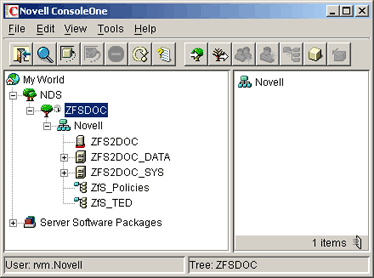
-
Right-click the context where you want to create the TED objects' container > click New > click Object.
-
Select Organizational Unit > click OK.
-
Enter a container name, such as TED > click OK.
IMPORTANT: Do not use double-byte or extended characters in object names.
-
Right-click the context where you want to create the Policy Package objects' container > click New > click Object > select Organizational Unit > click OK.
-
Enter a container name, such as Policies > click OK.
IMPORTANT: Do not use double-byte or extended characters in object names.
If you will also have ZENworks for Desktops (ZfD) policies, you can maintain policies from both ZfS and ZfD in the same container, especially because the two products share some policy packages. Or, you can name your Policy containers separately.
Preparing to Install Policy and Distribution Services
To complete installation preparations:
-
Review the Readme for any last-minute information concerning installation.
README.TXT is located at the root of the ZENworks for Servers Program CD or in the ZENWORKSFORSERVERS directory on the ZENworks 6 Server Management Program CD. READMEZFS302.HTML is located in the DOCUMENT directory on the Program CD, and the most up-to-date HTML version is located on the Novell Documentation Web site.
-
Make sure you have fulfilled all of the basic installation requirements (see Meeting Basic ZfS Installation Requirements).
-
Make sure you have fulfilled all of the server requirements (see Policy and Distribution Services Minimum Requirements for Windows Servers).
-
If Java* has not been unloaded on the target NetWare servers, unload JAVA.NLM.
For example, at each NetWare server's console prompt, enter:
java -exit
IMPORTANT: This command stops all Java processes running on the server. Make sure that all Java processes have been stopped before you install Policy and Distribution Services.
-
To install from a hard drive instead of the Program CD, copy the CD structure to a location on your installation workstation's hard drive.
We recommend that you install Policy and Distribution Services from the Program CD.
IMPORTANT: If you copy the Program CD structure to the installation workstation's hard drive, the path between the root of the hard drive and the first CD directory can contain only directory names that conform to the 8.3-character DOS file naming convention. If any long directory names exist in the path, the installation program will not work.
-
If you have any instance of ConsoleOne running on a target server via a mapped drive from a workstation, or running from the installation workstation, exit those instances of ConsoleOne before running the installation program.
If ConsoleOne is running on target server via a mapped drive on your installation workstation, or from the installation workstation, the ZfS snap-ins for ConsoleOne will fail to be installed at those locations.
-
On the workstation you will use to install Policy and Distribution Services, if you have not already done so, log in to all eDirectory trees where you will be installing the Distributor and Subscriber software.
You will automatically be authenticated to all of the NetWare target servers in the trees you are logged in to during installation, so that you can select those servers for installing the Policy and Distribution Services software.
You will be extending the schema for ZfS on one of these trees. Regardless of where a target server resides, its TED object (Distributor or Subscriber) will be created in the tree where you extend the schema in Extending the Schema.
-
If you will install software to any Windows servers, make sure you have authenticated to the servers or a domain containing the servers.
This will enable you to select Windows servers for installing the Distributor and Subscriber software. However, if you are not logged in to a Windows server before starting the installation, you will be able to authenticate during installation using a username and password in the Add Server dialog box where you select the Windows server for installation.
Installing Policy and Distribution Services
To install Policy and Distribution Services, do the following in order:
Starting the Installation Program
-
Do one of the following to display the main installation menu:
-
If you copied the CD to a hard drive, run WINSETUP.EXE from that hard drive location.
-
On the installation workstation, insert the ZENworks for Servers Program or ZENworks 6 Server Management Program CD.
The startup screen is displayed. If the startup screen is not automatically displayed after inserting the CD, run WINSETUP.EXE at the root of the CD.
-
Continue with Extending the Schema.
Extending the Schema
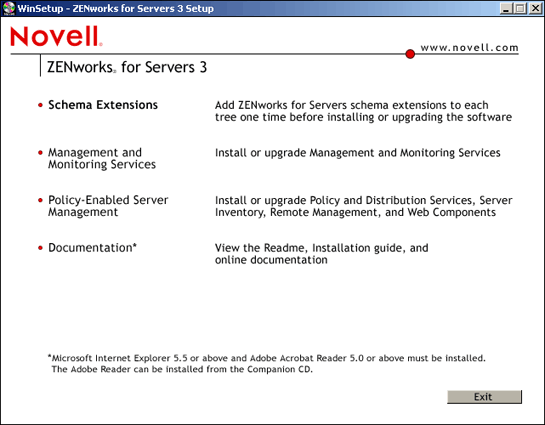
-
To extend the schema for ZfS objects, click Schema Extensions to display the Select Tree dialog box.
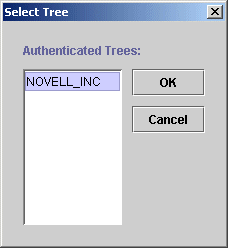
-
Select the tree where you want the ZfS objects created > click OK.
ZfS schema extensions need to be done only once for a tree. Schema extensions for all ZfS components (Management and Monitoring Services, Policy and Distribution Services, Server Inventory, and Remote Management) are installed at once.
After the schema extension process has completed, the main installation menu is again displayed.
-
Continue with Selecting to Install Policy and Distribution Services.
Selecting to Install Policy and Distribution Services
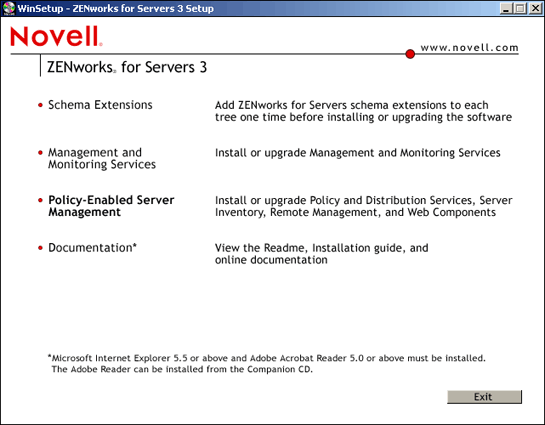
-
On the main installation menu, click Policy-Enabled Server Management to display the following submenu:
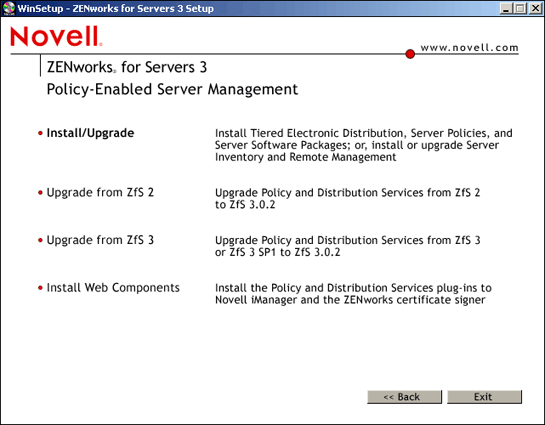
-
Click Install/Upgrade to display the License Agreement page.
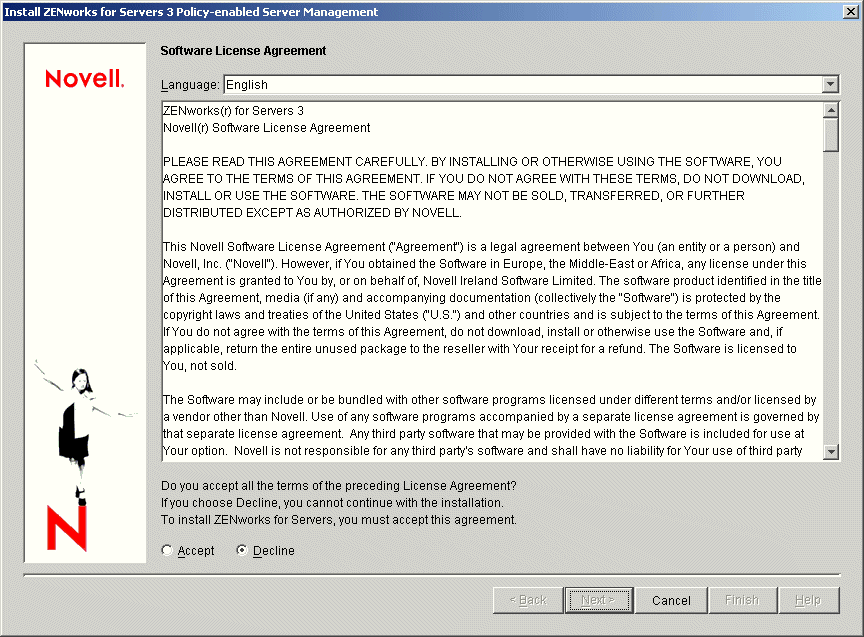
-
If you agree with the Software License Agreement, click Accept > Next to display the Installation Type page.
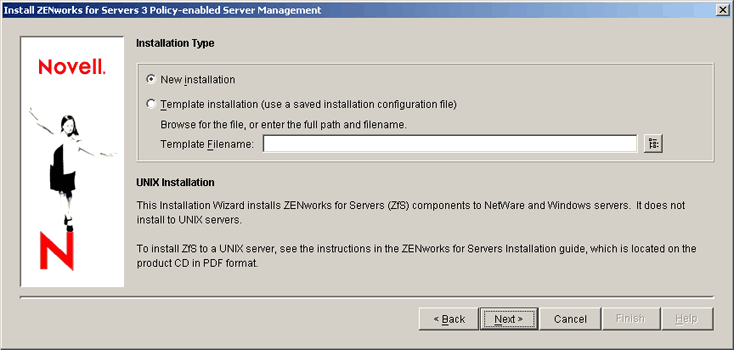
-
On the Installation Type page, click Next to perform a new installation and display the Components to Install page.
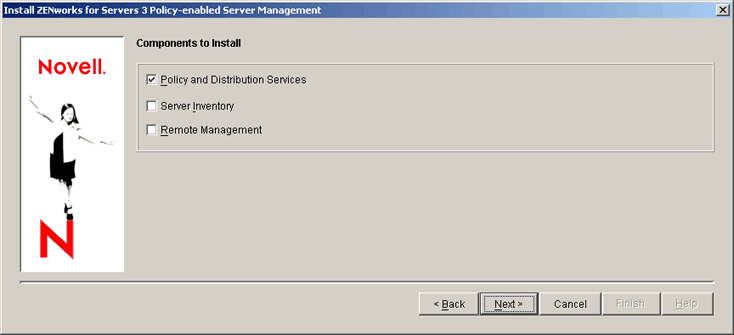
-
On the Components To Install page, click Next to install Policy and Distribution Services and display the Installation Options page.
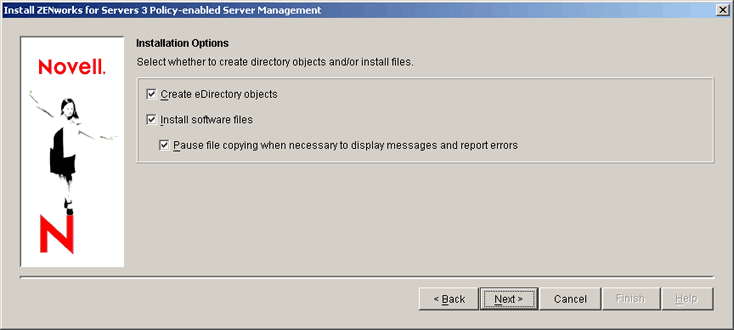
-
On the Installation Options page, click Next to accept the defaults and display the Select Tree page.
-
Continue with Selecting the Servers.
Selecting the Servers
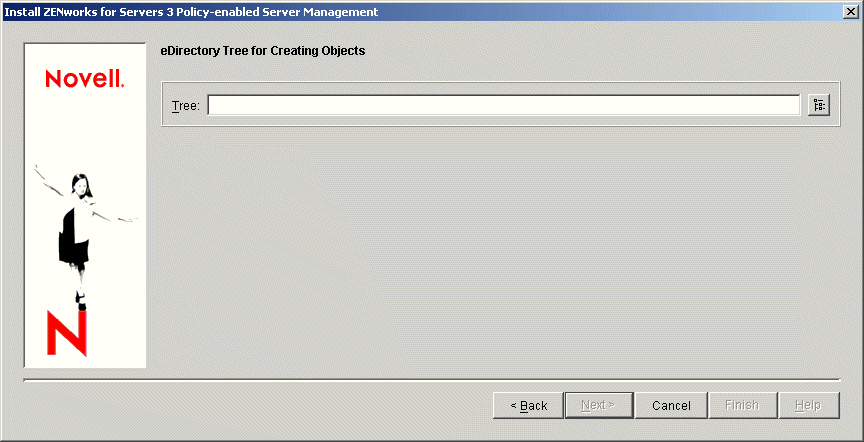
-
Browse for the target tree > click OK > click Next to display the Server Selection page.
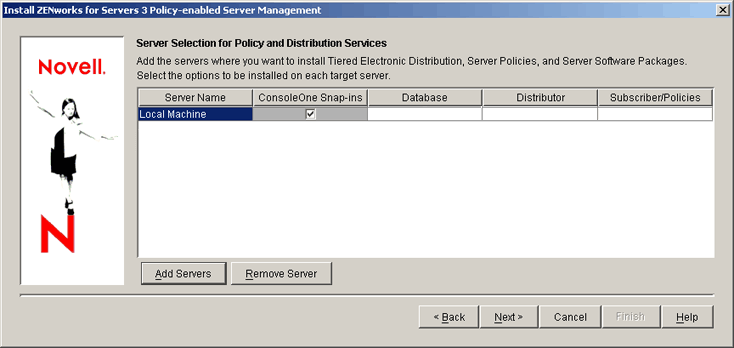
-
On the Server Selection page, click Add Servers to display the Add Servers dialog box.
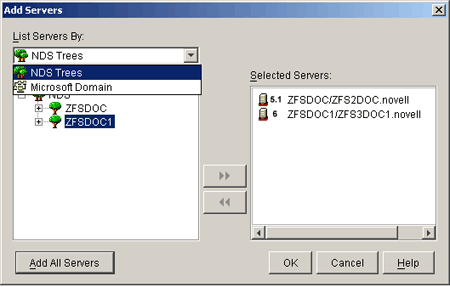
-
Browse for the servers that you want to be the Distributor and the Subscribers > click OK to place the selected servers into the Server Selection page.
The Add Servers option displays the Add Servers dialog box, where you can browse for both NetWare and Windows servers by selecting either NetWare trees or Microsoft domains from a drop-down box. You can select servers individually or in multiples (using Ctrl and Shift). You can also select groups of servers by selecting eDirectory containers, Windows workgroups, and Microsoft domains.
IMPORTANT: Remember, if you only intend for a particular Windows server to be used as an External Subscriber, then do not install the Subscriber object and software at this time.
For more information on using the Add Servers dialog box, click its Help button.
Make sure you have selected all of the NetWare and Windows servers before exiting the Add Servers dialog box.
Also browse for the workstations where you want the ConsoleOne snap-ins installed. You must have previously installed ConsoleOne to each of these workstations from the ZENworks for Servers Companion CD or the ZENworks 6 Companion 1 CD.
-
On the Server Selection page, if you installed ConsoleOne on your installation workstation, click the ConsoleOne Snap-ins check box for Local Machine.
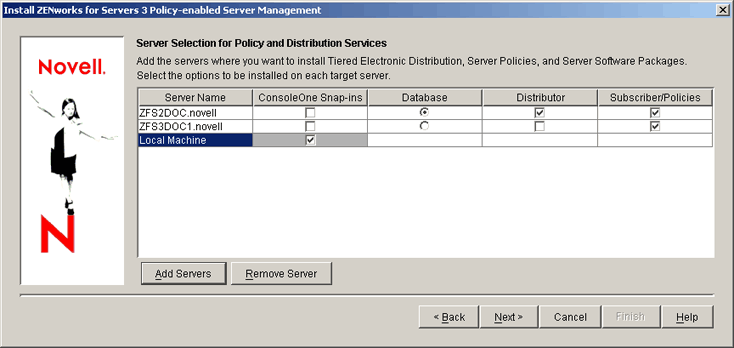
-
For any server where you installed ConsoleOne, click the ConsoleOne Snap-ins check box.
IMPORTANT: ZfS does not support running from a server's console an instance of ConsoleOne installed on that NetWare server. To use the server's installation of ConsoleOne, you must map a drive from a workstation to that server and run ConsoleOne from the workstation.
-
For the server you want to be the Distributor, click the Database radio button.
Because the Distributor Agent will write more often to the database than the Policy/Package Agent, install the database on the same server that you will select for the Distributor.
-
For the server you want to be the Distributor, click the Distributor check box.
The Subscriber/Policies check box is automatically checked. You can keep this option enabled for the Distributor server. If you disable the Subscriber/Policies check box, the Subscriber object will not be created. Even though the Subscriber/Policies check box is enabled for a Distributor, that doesn't mean the Distributor will also be used as a Subscriber. The Subscriber functionality is used only when you select the server to receive Distributions.
-
For all servers that you want to be Subscribers, click the Subscriber/Policies check box.
To select all, right-click the column.
-
When you have finished configuring the selected servers, click Next to display the File Installation Paths and Options page.
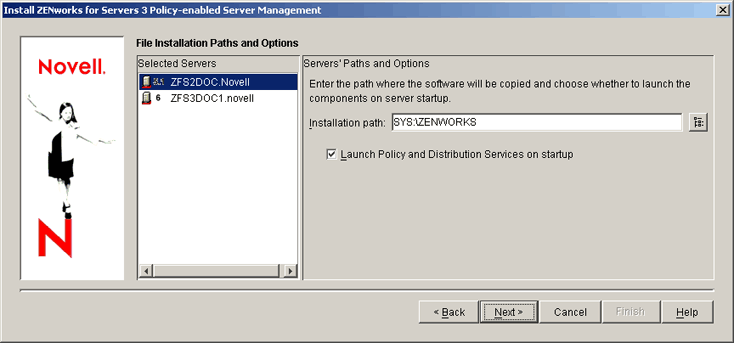
If you have invalid DNS names, you could receive an error message asking whether to continue installing using IP addresses. Either fix the DNS name problems, or continue by using IP addresses for the affected servers.
WARNING: If you continue with only IP addresses, you must manually enter the correct DNS host name on the Other tab in the server object properties of these servers in order to use Policy and Distribution Services.
IMPORTANT: During installation, ZfS updates .NCF files with installation path information. Because NetWare uses a DOS code page instead of a Windows code page, double-byte or extended characters cannot be used in paths, or the .NCF files will not execute. Therefore, do not use double-byte or extended characters in any part of an installation path, including a NetWare volume name.
-
Click Next to accept the defaults on the File Installation Paths and Options page.
If you change the beginning of the path to a different volume or drive, or insert other path information before ZENWORKS, then all subsequent paths displayed in the installation program will automatically match your changes.
IMPORTANT: Do not use double-byte or extended characters in any part of an installation path, including a NetWare volume name.
The Distributor Object Properties page is now displayed.
-
Continue with Defining the Distributor Object's Properties.
Defining the Distributor Object's Properties
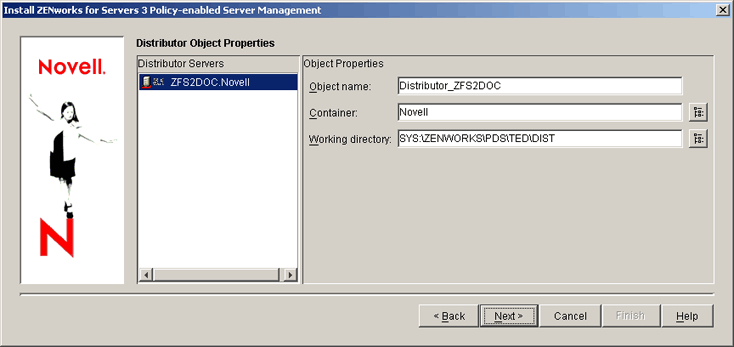
-
If you want to rename the Distributor object, edit the Object Name field.
If you want to rename the Distributor object, we recommend that you maintain the server's identity in the name, including the fact that it is a Distributor.
IMPORTANT: Do not use double-byte or extended characters in object names.
-
For the Container field, browse for and select the TED container you created in Step 3 under Creating ZfS Object Containers.
If eDirectory is not installed on each Windows NT/2000 server, the servers will not have a default container object displayed. If your Distributor will be installed to a Windows server, make sure you select a container for the Distributor object.
-
To use a different volume, drive, or directory path for the Distributor's working files, edit the default path.
Because the working directory has the potential to be quite large (depending on the size of the Distributions), make sure you have enough disk space. The default volume on a NetWare server is SYS:. For NetWare servers we strongly recommend that you specify a different volume.
-
Click Next to display the Subscriber Object Properties page.
-
Continue with Defining the Subscriber Objects' Properties.
Defining the Subscriber Objects' Properties
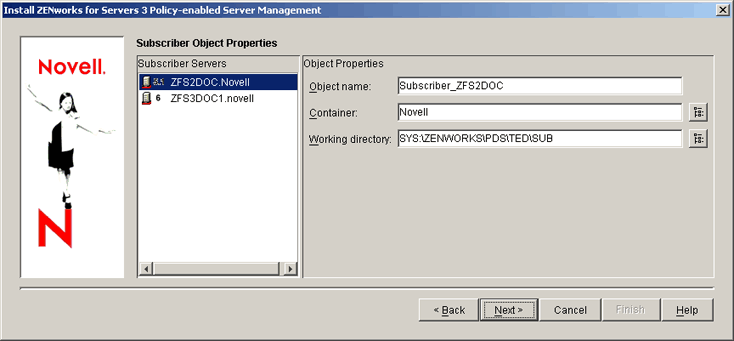
-
If you want to rename the Subscriber objects, select one or more Subscribers > edit the Object Name field > repeat as necessary.
If you want to rename the Subscriber objects, we recommend that you maintain the servers' identities in their names, including the fact that they are Subscribers.
IMPORTANT: Do not use double-byte or extended characters in object names.
-
For the Container field, browse for and select the TED container you created in Step 3 under Creating ZfS Object Containers.
You can use the same context for all Subscriber servers.
If eDirectory is not installed on each Windows NT/2000 server, the servers will not have a default container object displayed. If you will install Subscribers to Windows servers, make sure you select a container for each Windows server for its Subscriber object.
-
To use a different volume, drive, or directory path for the Subscriber's working files, edit the default path.
Because the working directory has the potential to be quite large (depending on the size of the Distributions), make sure you have enough disk space. The default volume on a NetWare server is SYS:. For NetWare servers we strongly recommend that you specify a different volume.
You might need to provide a different path for each Subscriber server.
-
Click Next to display the Database Settings page.
-
Continue with Defining the ZENworks Database Object's Properties.
Defining the ZENworks Database Object's Properties
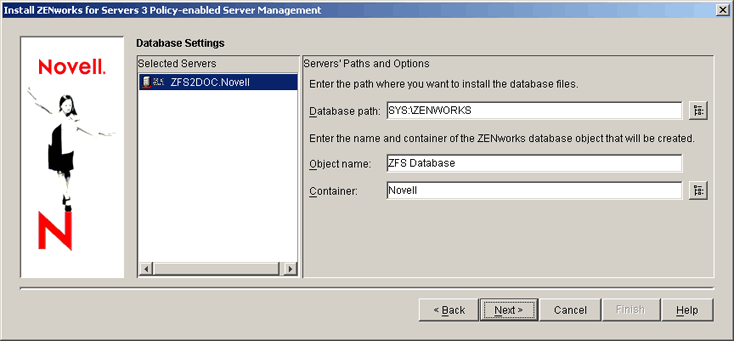
-
To change the path for the database file, edit the Database Path field.
Because the database file can become very large, we recommend that you change the default NetWare volume from SYS: to another volume on that server.
-
To accept the other defaults on the Database Settings page, click Next to display the Summary page.
-
Continue with Finishing the Installation Program.
Finishing the Installation Program
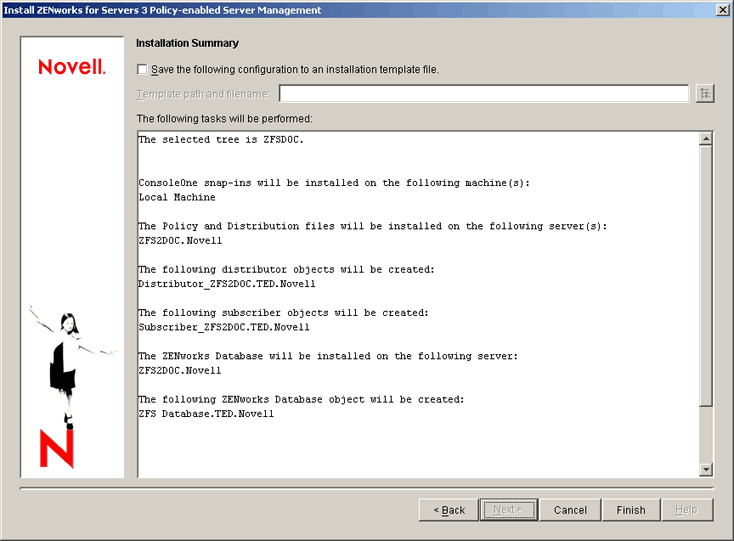
-
On the Installation Summary page, click Finish to begin the installation process.
You do not need to save this configuration, because you will normally run this particular installation configuration only once.
-
After the installation program has finished, review the installation log file to determine whether any components failed to install.
The log file is located at:
C:\TEMP\_RESnnn.TXT
where nnn is increased incrementally each time a new installation log is created.
If you receive error messages during installation, see Installation Error Messages.
-
If necessary, rerun the installation program.
Select only the components that failed to install.
-
Click Exit to close the main installation program.
At this time, Policy and Distribution Services objects have been created and the software has been installed. You must perform other tasks in the following sections to have an operational distribution system.
-
If your network has both eDirectory 8.x and NDS® 7.x installed, continue with Setting Up the Distributor in a Mixed Network Operating System Environment; otherwise, skip to Completing the Installation Process.
Setting Up the Distributor in a Mixed Network Operating System Environment
If your network has both eDirectory 8.x and NDS 7.x installed, you need to edit the TED.NCF file on your NetWare Distributor server to ensure that the Distributor server will be able to authenticate to the eDirectory 8.x tree.
To edit the TED.NCF file:
-
On the Distributor server's file system, open SYS:\ZENWORKS\PDS\TED\TED.NCF in a text editor.
The path to your ZENWORKS directory can be different if you used a different volume or inserted other path information between the volume and the ZENWORKS directory.
-
Locate the line similar to the following (usually at the end of the file):
java -mx128M -envDISPLAY=127.0.0.1:0 -noclassgc -ns -jstedexit -snTed -classpath $tedpath com.novell.application.zenworks.ted.TED CORPTREE "Distributor_Server001.TED.ZENworks.Novell" distributor_password
-
Locate the server's tree name (usually immediately after the com.novell.application.zenworks.ted.TED phrase) > replace it with the IP address of a server that has eDirectory 8.x installed.
The IP address can be for any server running eDirectory 8.x. This can include the Distributor server where you are editing the TED.NCF file.
The line should now appear as:
java -mx128M -envDISPLAY=127.0.0.1:0 -noclassgc -ns -jstedexit -snTed -classpath $tedpath com.novell.application.zenworks.ted.TED 155.55.155.55 "Distributor_Server001.TED.ZENworks.Novell" distributor_password
-
Save the configuration file > exit the text editor.
-
If you installed more than one Distributor, repeat Step 1 through Step 4 for each Distributor.
-
Continue with Completing the Installation Process.
Completing the Installation Process
To complete your installation of Policy and Distribution Services, do the following:
Configuring the Policy and Distribution Agents on Servers with Multiple Network Addresses
If a server where you have installed the Policy and Distribution Services agents has multiple network addresses on your network, some additional configuration is necessary before you start the agents. This situation arises when the server has one or both of the following characteristics:
- Multiple NICs
- Multiple DNS host names
To ensure that forward and reverse DNS lookups are successful, you need to edit a configuration file for each applicable server on the following platforms:
NetWare
For a NetWare server with multiple network addresses:
-
Open the following file in a text editor:
Installation_path\ZENWORKS\PDS\TED\TED.NCF
-
Scroll to the bottom of the file and locate the class:
.com.novell.application.zenworks.ted.TED
-
Insert the -hosts switch after the class.
-
For a server with multiple NICs, specify all bound IP addresses and any additional DNS host names that the server is known by on your network. For example:
-hosts 123.45.67.89;123.45.67.90;svr5.novell.com
or
For a server with multiple DNS host names, specify all the host names that the server is known by on your network. For example:
-hosts svr6.novell.com;sales.novell.com
IMPORTANT: The IP addresses and host names must be separated by semicolons (;).
-
Save your changes > exit the text editor.
-
Continue with Windows or Starting the Policy and Distribution Services Agents.
Windows
For a Windows server with multiple network addresses:
-
Open the following file in a text editor:
Installation_path\ZENWORKS\PDS\BIN\TEDSRV.CFG
-
For a server with multiple NICs, specify all bound IP addresses and any additional DNS host names that the server is known by on your network by adding the following line in the .CFG file:
FLAGS=" -hosts 123.45.67.89;123.45.67.90;svr5.novell.com;devel.novell.com"
IMPORTANT: The quotation marks are necessary to preserve the space between -hosts and the IP addresses or DNS names. Also, the IP addresses and host names must be separated by semicolons (;).
-
For a server with multiple DNS host names, specify all the host names that the server is known by on your network by adding the following line in the .CFG file:
FLAGS=" -hosts svr6.novell.com;sales.novell.com"
IMPORTANT: The quotation marks are necessary to preserve the space between -hosts and the IP addresses or DNS names. Also, the host names must be separated by semicolons (;).
-
Save your changes > exit the text editor.
-
Continue with Starting the Policy and Distribution Services Agents.
Starting the Policy and Distribution Services Agents
To start the Policy and Distribution Services agents for the first time:
-
Go to a server where you installed the Distributor or a Subscriber.
You can check the installation log file on the workstation you used to install ZfS 3.0.2 to see which servers had the Distributor and Subscriber software installed.
-
To start Policy and Distribution Services on a supported operating system, do the following:
To start ZfS, enter the following command at the server's console prompt: sys:\zenworks\pds\smanager\zfs.ncf If you used a different volume, or added other path information before the ZENWORKS directory, replace the SYS: portion with the alternate path information. After you have started ZfS in this manner, and after the server has rebooted once, the full path will no longer be needed for start the software---you will only need to enter zfs. By entering the path the first time you run ZFS.NCF, or by rebooting the server after installing ZfS, you can enable the server to learn the path. TED.NCF and ZWS.NCF are started automatically by the ZFS command. The database is automatically started by the installation program. |
Do the following on each Windows server: - Open the Control Panel.
- Do the applicable task:
On Windows NT, double-click Services.
or
On Windows 2000, double-click Admin Tools > double-click Services. - Start the Novell ZfS Policies service.
This will also start the Novell ZfS Distribution and Novell Zen Web Server services. The Novell Sybase Database service is automatically started by the installation program.
|
IMPORTANT: If you edited the TED.NCF file for a Distributor that already has ZfS running (as instructed in Setting Up the Distributor in a Mixed Network Operating System Environment), bring the ZfS Agent down and restart it on that server.
-
Repeat these steps for all target servers.
-
Continue with Verifying That the Policy and Distributions Services Agents Are Loaded.
Stopping the Policy and Distribution Services Agents
Occasionally, you might need to stop ZfS. The following is provided for future reference. Do not perform these functions at this time.
To stop ZfS on a supported operating system, do the following:
To stop ZfS completely, enter the following command at the applicable server's ZfS console prompt: EXITALL ZFS.NCF, TED.NCFand ZWS.NCF are stopped automatically by the EXITALL command when it is executed at the ZfS console. |
To stop only the Policy/Package Agent (ZFS.NCF), enter the following command from the ZfS console: EXIT IMPORTANT: The EXIT command does not exist for ZWS.NCF, because the Zen Web Server software is required for ZfS to function. The EXIT command also does not exist for TED.NCF, because ZfS requires TED for distributing policies. |
Do the following on the applicable Windows server: - Open the Control Panel.
- Click Services. (In Windows 2000, Services is under Admin Tools.)
- Click Novell ZfS Policies > click Stop.
This will stop the Subscriber Agent. To stop ZfS, this service should be stopped first, and the other two can be stopped in any order thereafter. - Click Novell ZfS Distribution > click Stop.
This will stop the Distributor Agent. - Click Novell Zen Web Server > click Stop.
This will stop the Zen Web Server.
|
Verifying That the Policy and Distributions Services Agents Are Loaded
To verify that the Policy and Distributions Services agents are running on the target servers:
When finished, continue with Setting Up the Necessary Server Policies.
Verifying on NetWare Servers
To verify if ZfS is running properly on a NetWare server:
-
On the target server's console, press Ctrl+Esc to view the loaded software programs.
-
If the ZfS item (Policy/Package Agent) is not displayed, review the ZFSINIT.TXT file (under ZENWORKS\PDS\SMANAGER), which contains information about why the agent did not start.
Use this information to reinstall ZfS to the server.
This file is used to log startup problems only.
-
If the TED item (TED Agent) is not displayed, review the DEFAULTLOG.TXT file (under PDS\TED), which contains information about why the agent did not start.
Use this information to reinstall ZfS to the server.
This file is used to log startup problems only.
-
Repeat Step 1 through Step 3 for each NetWare server.
-
If necessary, rerun the installation program (see Installing Policy and Distribution Services).
Verifying on Windows Servers
To verify if ZfS is running properly on a Windows server:
-
On the target server, open the Control Panel > double-click Services (on Windows 2000, double-click Admin Tools > click Services) > determine if the following services are running:
- Novell ZfS Policies
- Novell ZfS Distribution
- Novell Zen Web Server
- Novell Sybase Database
-
Repeat Step 1 for each Windows server.
-
If necessary, rerun the installation program (see Installing Policy and Distribution Services).
-
Continue with Setting Up the Necessary Server Policies.
Setting Up the Necessary Server Policies
The following policies are used for reporting or notification purposes. You should create and distribute some or all of the following server policies after installing ZfS:
ZENworks for Servers policy (Distributed Server Package): This policy enables you to specify how information is purged from ZFSLOG.DB. This database file grows with every Policy and Distribution Services success or failure logged. You can use this policy to prevent ZFSLOG.DB from becoming excessively large. This policy is distributed.
ZENworks Database policy (Service Location Package): This policy identifies the database for logging information about policy successes and failures. Without this policy, policy reports will contain no data. The database file is named ZFSLOG.DB. This policy is associated.
Search policy (Container Package): This policy is used by the Distributor Agent to locate Service Location Package policies (such as the ZENworks Database policy), because the Distributor does not receive polices through Distributions, as do the Subscribers. This policy is associated.
SMTP Host policy (Distributed Server Package): You must have this policy in effect if you want to use the e-mail notification option in the Distributor, Subscriber, or Policy Package objects. This policy is distributed.
Review each of the following sections to configure the necessary policies:
Creating and Configuring the ZENworks for Servers Policy
This policy is distributed to the Subscriber server for the Policy/Package Agent. It provides basic ZfS parameters for each server, in case you do not modify these properties for every Subscriber object.
The ZENworks for Servers policy contains information, such as:
- The path and filename for the log file where the Policy/Package Agent writes policy status information
- The messaging levels for the server's console, SNMP traps, and log files
- Whether to provide e-mail notifications
- The path for the working directory used by the Policy/Package Agent
- The console prompt for the server
- The number of days before purging the database of policy information
The log file path will be specific to the operating system where the Policy/Package Agent is running. This log file path could be different for every server, or groups of servers. Because operating system's file systems are unique, when you create the ZENworks for Servers policy you will at least need one instance of the policy for the Linux and Solaris servers, one instance for the Windows NT/2000 servers, and one instance for the NetWare servers.
To create the ZENworks for Servers policy:
-
In ConsoleOne, browse eDirectory for the container you created specifically for Policy Package objects.
-
Right-click the policies container > click New > click Policy Package to open the Policy Package Wizard.
-
Under Policy Packages, select Distributed Server Package > click Next.
-
Name the package > click Next > click Finish to create the package.
You can accept the default name of Distributed Server Package.
-
Right-click the Distributed Server Package > click Properties > click the Policies tab > click a platform from the following subtabs:
- Windows
- NetWare
- Linux
- Solaris
The policies contained in the Distributed Server Package are specific to platforms because of directory paths that are used for working directories and log files and other policy attributes. Therefore, the General tab is not used.
-
Click the box under the Enabled column for the ZENworks for Servers policy to enable it > click Properties.
-
Click the ZENworks for Servers tab.
-
Enter a console prompt.
You can customize the NetWare prompt using plain text and/or variables. The default is:
%SERVER_DN% - ZfS>
You can use any of the predefined or user-defined variables.
-
Enter a working directory.
This is for the Server Policies component's temporary files. Use the following information to determine the working directory name and path:
volume:\path\ZENWORKS\PDS\SMANAGER\working_directory For example: DATA:\NOVELL\ZENworks\PDS\SManager\Work where DATA is the volume and NOVELL is the user-defined path. The ZfS installation program inserts the \ZENWORKS\PDS\SMANAGER directories, which can be renamed for the working directory. We strongly recommend that you do not use the SYS: volume. |
/usr/ZENworks/PDS/smanager/working_directory For example: /usr/ZENworks/PDS/smanager/work The working directory name is the only part of the path that you can rename. |
drive:\path\ZENWORKS\PDS\SMANAGER\working_directory For example: D:\NOVELL\ZENworks\PDS\SManager\Work where D: is the drive and NOVELL is the user-defined path. If you select a different drive than C:, it must be shared. The ZfS installation program inserts the \ZENWORKS\PDS\SMANAGER directories, which can be renamed. |
-
To determine how old database information should be before purging, enter a number of days > click OK.
All ZfS information older than the number of days entered is automatically purged.
If you want to use the option to automatically purge the database, the Policy/Package Agent must be running on the same server where ZFSLOG.DB is located. For example, if you installed the database to a Distributor server, you should also leave the Subscriber/Policies column checked for that Distributor server during installation.
-
Repeat Step 5 through Step 10 for each operating system.
You should enable the ZENworks for Servers policy on each operating system tab for each operating system in your network to provide certain defaults for all Distributor, Subscriber, and ZENworks Database objects.
-
When you are finished, click OK > continue with Creating and Configuring the Search Policy.
Creating and Configuring the Search Policy
In ZfS 3.0.2, the Search policy is needed by the Distributor Agent for locating Service Location Package policies (such as the ZENworks Database policy), because the Distributor cannot receive this information through Policy Package type Distributions. The Service Location Package must be associated.
The Subscriber Agent receives its database location information through Policy Package type Distributions, so it does not use the Search policy.
This policy is associated with the Distributor object's container for the Distributor Agent.
To configure the required attributes for the Search policy:
-
In ConsoleOne, browse eDirectory for the container you created specifically for Policy Package objects.
-
Right-click the container > click New > click Policy Package to open the Policy Package Wizard.
-
Under Policy Packages, select Container Package > click Next.
-
Name the package > click Next > click Finish.
You can accept the default name of Container Package.
-
Right-click the Container Package > click Properties > click the Policies tab.
-
Click the box under the Enabled column for the Search policy to enable it > click Properties.
-
Click the Search Level tab.
-
To determine the upper limits of the Search policy, select Object Container from the drop-down list.
This will stop the search at the parent container of the Distributor's server object.
-
To determine the order of searching for the Search policy, click the arrow buttons to reorder the Object, Group, and Container options as necessary.
You do not need to configure the Refresh Interval tab.
-
Click the Associations tab > click Add.
-
Browse to the container containing the Distributor object > click Apply > click Close.
If you have your Distributor object in a different container, add the other container to the list.
-
Click OK when finished associating the Container Package > continue with Creating and Configuring the ZENworks Database Policy.
Creating and Configuring the ZENworks Database Policy
If you installed the ZENworks database, the Policy/Package Agent and Distributor Agent both need this policy.
The policy includes the Database object's DN, which provides the location to the ZENworks Database object that contains the location of ZFSLOG.DB for logging reporting information.
The Distributor Agent and the Policy/Package Agent write Distribution and policy status information to ZfSLOG.DB. The information in this database is accessed by ZfS for creating reports. For more information on ZfS reporting, see "Reporting" in "Policy and Distribution Services" in the Administration guide.
The information written to ZFSLOG.DB is different from the information written to the Distributor and Subscriber server log files. The database file provides report information on the status of Distributions, whereas the log files are used for determining the cause of a server problem.
This policy is associated with the Distributor object's container for the Distributor Agent and is distributed to the Subscriber server for the Policy/Package Agent.
Perform the following applicable tasks:
For the Distributor Agent
To configure the required attributes for the ZENworks Database policy:
-
In ConsoleOne, browse eDirectory for the container you created specifically for Policy Package objects.
-
Right-click the policies container > click New > click Policy Package to open the Policy Package Wizard.
-
Under Policy Packages, select Service Location Package > click Next.
-
Name the package > click Next > click Finish to create the package.
Name the package so that it is identified with its ZENworks Database object.
-
Right-click the Service Location Package > click Properties > click the Policies tab.
-
Click the check box under the Enabled column for the ZENworks Database policy to enable it > click Properties.
-
Click to make sure you are viewing the Policy/Distribution Management tab.
-
Browse for a Database object or enter its DN > click Apply > click Close.
For example, the Database object might read:
ZfS Database.Development.Novell
The Database object was automatically created when you installed the Database. It is located in the same container as the Server object where the database was installed.
-
Click the Associations tab > click Add.
-
Browse to the container containing the Distributor objects > click Apply > click Close.
If you have your Distributor objects in different containers, add the other containers to the list.
-
Click OK when finished associating the Service Location Package > continue with For the Policy/Package Agent.
For the Policy/Package Agent
To configure the required attributes for the ZENworks Database policy:
-
In ConsoleOne, browse eDirectory for the container you created specifically for Policy Package objects.
-
Right-click the Distributed Server Package that you created for the ZENworks for Servers policy under Creating and Configuring the ZENworks for Servers Policy > click Properties > click the Policies tab.
-
On the Policies tab, select the platform.
If you want the ZENworks Database policy to apply equally to all platforms, select General (the default).
-
Click the check box under the Enabled column for the ZENworks Database policy to enable it > click Properties.
-
Click to make sure you are viewing the Policy/Distribution Management tab.
-
Browse for a Database object or enter its DN > click OK.
-
Click Apply > click Close to close the Distributed Server Package properties.
For example, the Database object might read:
ZfS Database.Development.Novell
The Database object was automatically created when you installed the Database. It is located in the same container as the Server object where the database was installed.
-
If you need to define this policy for different platforms, repeat Step 3 through Step 7 for each platform.
-
Click OK > continue with Creating and Configuring the SMTP Host Policy.
Creating and Configuring the SMTP Host Policy
If you want to use the e-mail notification option in the Distributor, Subscriber, or Policy Package objects, the Distributor Agent and Policy/Package Agent need this policy.
This policy is associated with the Distributor object's container for the Distributor Agent and is distributed to the Subscriber server for the Policy/Package Agent.
Perform the following applicable tasks:
For the Distributor Agent
To configure the required attributes for the SMTP Host policy:
-
In ConsoleOne, browse eDirectory for the container you created specifically for Policy Package objects.
-
Right-click the policies container > click New > click Policy Package to open the Policy Package Wizard.
-
Under Policy Packages, select Distributed Server Package > click Next.
-
Name the package > click Next > click Finish to create the package.
Name the package so that it is identified as an associated SMTP Host policy for the Distributor Agent.
-
Right-click the Distributed Server Package > click Properties > click the Policies tab.
-
Click the SMTP Host policy > click Properties.
If the box under the Enabled column is not checked for the SMTP Host policy, click it before clicking Properties. A policy must be enabled to activate the Properties button.
-
Enter the TCP/IP address or DNS name of the relay host server > click OK.
-
To associate the Service Location Package with the OUs that contain Distributor objects so that the SMTP Host policy will be enforced on the Distributor:
-
Click the Associations tab > click Add.
-
Browse to select the container where the Distributor object resides (or any container above it) > click OK.
If you click Cancel, the association you made will not be saved.
-
Click OK when finished > continue with For the Policy/Package Agent.
For the Policy/Package Agent
To configure the required attributes for the SMTP Host policy:
-
In ConsoleOne, browse eDirectory for the container you created specifically for Policy Package objects.
-
Right-click the Distributed Server Package that you created for the ZENworks for Servers policy under Creating and Configuring the ZENworks for Servers Policy > click Properties > click the Policies tab.
-
On the Policies tab, select the platform.
If you want the SMTP Host policy to apply equally to all platforms, select General (the default).
-
Click the SMTP Host policy > click Properties.
If the box under the Enabled column is not checked for the SMTP Host policy, click it before clicking Properties. A policy must be enabled to activate the Properties button.
-
Enter the TCP/IP address or DNS name of the relay host server > click OK.
-
If you need to define this policy for different platforms, repeat Step 3 through Step 5 for each platform.
-
Click OK when finished > continue with Creating and Sending the Policy Distribution.
Creating and Sending the Policy Distribution
Some of the policies you just created must be distributed to be put into effect.
Do the following to create and distribute these policies:
Creating and Configuring the Policy Package Distribution
-
In ConsoleOne, browse eDirectory for the container you created specifically for TED objects.
-
Right-click the policies container > click New > click Object > select TED Distribution > click OK.
-
Enter a Distribution name > select the Distributor > select the Define Additional Properties option > click OK.
-
Click the Type tab > select Policy Package in the Select Type field > click Add.
-
In the Select Objects dialog box, browse for the Distributed Server Package that contains the following policies you created in the previous sections (see Creating and Configuring the ZENworks for Servers Policy):
- ZENworks for Servers
- ZENworks Database
- SMTP Host
-
Click Select to place the policy package into the Selected Objects box > click OK.
-
Click the Schedule tab > select Run Immediately in the Schedule Type field.
-
Click OK to close the Distribution's properties.
-
Right-click the policies container > click New > click Object > select TED Channel > click OK.
-
Enter a Channel name > select the Define Additional Properties option > click OK.
-
Click the Distributions tab > click Add.
-
Browse for the Distribution you created in Step 3 > click Select > click OK.
-
Click the Subscribers tab > click Add.
-
Browse for each server where you installed Subscriber software > click Select for each server > click OK when finished.
You can select multiple servers before clicking Select.
If asked to copy certificates, do so.
-
Click OK to close the Channel's properties > continue with Creating and Sending the Policy Distribution.
Setting Subscribers' Extraction Schedules
Before a Subscriber can use a Distribution that is sent to it via TED, it must extract the Distribution. Therefore, the Subscriber's extraction schedule must be set before sending the Distributions.
-
In ConsoleOne, select a group of Subscriber objects for servers that you want to use the same extraction schedule > right-click the selected group > click Properties.
Because you can do multiple editing of eDirectory objects, you can select all of the Subscribers that will use the same extraction schedule and edit the Extract Schedule field once for all of them.
-
Click the Schedule tab > click the arrow for the drop-down box (Run Immediately defaults) > click OK.
This will cause the selected Subscribers to extract the Distributions as soon as they are received.
-
Repeat Step 1 and Step 2 as necessary until all Subscriber schedules have been set.
Setting the Channel's Send Schedule
The Channel's Send schedule must be set before its Distributions can be sent.
-
In ConsoleOne, right-click the Channel object.
This is the Channel for the policies Distribution you created in Step 9 under Creating and Configuring the Policy Package Distribution.
-
Click the Schedule tab > click the arrow for the drop-down box > click Interval.
-
Under Repeat Action Every, select 5 minutes.
-
Click OK.
Sending the Policy Distribution
-
In ConsoleOne, right-click the Distributor object.
-
Click the Schedule tab.
If the Distributor's Refresh schedule is set to Never, reset it to be an interval of every five minutes.
-
Click Refresh Distributor.
This causes the Distributor to re-read eDirectory and obtain all of the changes that were made in eDirectory.
Building the Distribution will begin immediately (according to the Build schedule you set previously). The Distribution will be sent within five minutes (according to the Send schedule you set previously).
As soon as the Subscribers receive the entire Distribution, they will extract the contents to the Subscriber's working directory that you specified in the Subscriber object's properties.
Continue with What's Next.

















